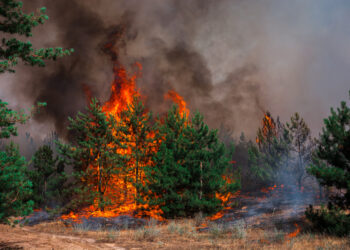Town hall meeting covers availability, ecological health, wastewater treatment
By Amanda Eggert EBS Associate Editor
BIG SKY – Approximately 120 people attended a town hall meeting held by the Big Sky Sustainable Water Solutions Forum at Buck’s T-4 on Dec. 6. The gathering was an effort to familiarize residents and interested parties with the area’s water challenges before the forum drills into solutions.
Before introducing the scope of the forum’s efforts, Gallatin River Task Force Executive Director Kristin Gardner outlined some of the problems coming down the pike.
Gardner said planning for climate change will be important as earlier snowmelt leads to decreased streamflows in the summer and early fall. She said watersheds will be further impacted by rising water temperatures, which make fisheries more susceptible to increased algae, depleted oxygen levels, and bacteria and disease proliferation.
Gardner then pulled up a growth chart that shows the Big Sky Water and Sewer District bumping up against its capacity for both water availability and wastewater treatment and storage by 2022 given projected development.
“We have about five years to come up with these additional options, and this is going to take some real serious thought,” Gardner said. “Where, when and how you dispose of wastewater and/or how you withdraw water within a watershed makes a huge difference on water quality and the amount of water that’s moving throughout the watershed.”
Currently, Big Sky’s water supply comes from wells and springs in the area, with the most productive aquifer in use located in Meadow Village underneath the golf course.
Mike Richter, a research scientist with the Montana Bureau of Mines and Geology, said that although the water supply has been pretty stable long term, there’s been a fair bit of demand on the resource.
“We’ve been busy in the last 20 years,” said Richter, a Big Sky resident, in reference to the number of wells that have been drilled. He also highlighted the fact that the groundwater is fed by snowmelt, streams, precipitation and infiltration and that alluvial wells are vulnerable to contamination.
Gallatin Basin is a closed basin, meaning small groundwater uses can still be developed but anything over 35 gallons per minute needs a permit, said Kerri Strasheim, a regional water manager with the Department of Natural Resources and Conservation.
Strasheim added that the water commissioner on the Gallatin evaluates water-right priorities by date awarded. Rights granted after 1890 are considered inferior to those granted prior to that date. New water uses in a closed basin can be mitigated by reallocating old water uses, but Strasheim said Big Sky does not have much historic use that can be applied toward such mitigation.
A representative from the Montana Department of Environmental Quality voiced his support for community-based water solutions that don’t require regulatory intervention from state agencies. “I’m going to talk myself out of a job tonight and really promote this grassroots effort,” said Eric Urban with the DEQ’s Water Quality Planning Bureau.
Nearly all of the nine panelists who spoke at the meeting expressed their support for a voluntary, community-based effort. A couple of similar efforts, namely those in Lake Tahoe and Yampa Valley, Colorado, were mentioned.
After the presentations wrapped up, forum facilitator Karen Filipovich asked the panelists approximately a dozen questions that attendees wrote down on note cards.
One regarded how using treated effluent for irrigation impacts the watershed. “I think that’s the main cause of the water-quality impairment that we have on the West Fork,” Gardner said, referencing nutrients that are introduced to the stream via golf course irrigation. Gardner added that engineering equations don’t always agree with how water moves through the system.
Several panelists expressed their belief that there would be no silver-bullet solution to the area’s water issues—wastewater treatment and disposal in particular—and it’s likely that a number of solutions will be implemented.
Another attendee wanted to know how many of the Yellowstone Club’s members are year-round residents. Mike DuCuennois, Vice President of Development at the Yellowstone Club, said that of 570 memberships, five or six are full-time residents.
Kevin Germain, vice president of development at Lone Mountain Land Company, which funded the forum’s initial efforts alongside the Yellowstone Club, reiterated the importance of protecting the area’s water resource.
“I don’t kid myself, people don’t buy a home from us because we build a nice home, they buy a home here because of the natural resources,” Germain said. “It’s imperative upon us to be stewards of this land and make sure we protect the golden goose.”












